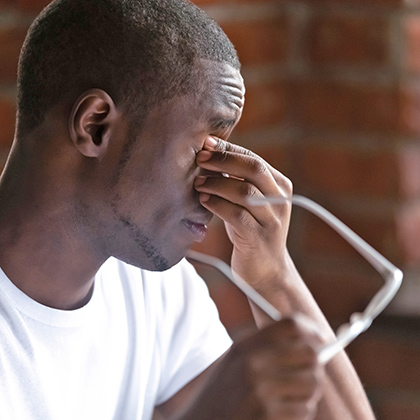
Glaucoma is a common eye condition that can if left untreated, lead to vision loss. According to the World Health Organization, 4.5 million people are estimated to have lost their sight as a result of having the most common type of glaucomai. Many people who do have treatment for glaucoma don’t have any sight problems as the treatment, typically in the form of eye drops, prevents vision loss.
Being diagnosed with glaucoma can be upsetting and come as a shock. The thought of having to manage your glaucoma may seem daunting, however, having a clear understanding of your condition can help you cope better.
What is glaucoma?
So, what is glaucoma exactly? The NHS describes it as an eye condition where the optic nerve, which connects the eye to the brain, becomes damagedii. This is usually a result of fluid building up in the front part of the eye, causing raised pressure in the eye (intraocular pressure or IOP). And while your eye needs a certain amount of pressure to stay healthy and to keep the correct shape, too much can damage your optic nerve.
There are several different types of glaucoma, including the following:
Primary open angle glaucoma
This is the most common type of glaucoma. It develops very slowly, so the damage to your optic nerve and changes to your vision happen very gradually.
Primary angle closure glaucoma
A rare form of glaucoma, this can develop slowly (chronic angle closure glaucoma) or quickly (acute angle closure glaucoma). The latter must be treated immediately to avoid any permanent vision damage.
Secondary glaucoma
This type of glaucoma develops as a result of an underlying eye condition such as uveitis (inflammation of the eye). Other things that may cause secondary glaucoma include eye surgery, injuries and certain medications.
Normal tension glaucoma
This type of glaucoma, also called normal pressure glaucoma, isn’t caused by increased IOP, since in these cases the pressure inside the eye is normal (one in five people is thought to have normal tension glaucoma).
What should you look out for?
The problem with most types of glaucoma is that there aren’t any symptoms in the early stages. The first part of the vision to be affected is the peripheral vision, the outer field of vision. Glaucoma usually affects both eyes, but often they aren’t affected to the same extent. This means your eyesight can often compensate for any problems happening around the edges of your vision, so you may continue to see normally until both eyes are more badly affected.
 If you do notice any symptoms, you may find your eyesight becoming hazy, or you may see rainbow-coloured circles around bright light. But if you develop the type of glaucoma that starts quickly (acute angle closure glaucoma) you could also experience symptoms such as intense eye pain, nausea, vomiting, headache, tenderness around the eyes and eye redness.
If you do notice any symptoms, you may find your eyesight becoming hazy, or you may see rainbow-coloured circles around bright light. But if you develop the type of glaucoma that starts quickly (acute angle closure glaucoma) you could also experience symptoms such as intense eye pain, nausea, vomiting, headache, tenderness around the eyes and eye redness.
Thankfully glaucoma that develops suddenly happens only very occasionally. So, since most cases come on gradually with no symptoms during the early stages, the only way to spot glaucoma is through screening. This means having regular eye tests. Your optician will know when to start testing you for glaucoma, or if you’re worried you can request a glaucoma test during a routine eye check-up.
What are the risk factors?
Age is the most common risk factor for glaucoma since the condition is most common in older people (usually those in their 70s and 80s). It can, however, affect you at any age. Besides age, other things that can increase your risk of glaucoma include the following:
-
Ethnicity (if you are of African, Caribbean or Asian origin, your risk is higher)
-
Family history (having a parent or sibling with glaucoma makes you more likely to develop it too)
-
Other medical conditions (people with diabetes have a higher risk of developing glaucoma, as do those who are very shortsighted or longsighted)
Lifestyle changes that can help
Exercise
If you’ve been diagnosed with glaucoma, your doctor will probably prescribe eye drops to reduce the pressure in your eyes. It’s also important to maintain a healthy lifestyle to support your vision in general. Staying active is useful as some studies suggest exercise lowers IOPiii, though researchers aren’t really sure why this happens. Some activities, on the other hand, may raise IOP, such as doing yoga poses where your heart is higher than your eye (the headstand, for instance).
Drinking coffee has been shown to increase IOP compared with not drinking coffee, with studies suggesting drinking more than five cups of caffeinated coffee a day may be linked with an increased risk of glaucomaiv.
It is, however, worth noting that while increased pressure in the eye is a major risk factor for glaucoma and lowering eye pressure is the most important part of medical glaucoma treatment, lifestyle factors that lower eye pressure may not protect you against developing glaucoma. Lifestyle factors that increase eye pressure don’t necessarily raise your risk of glaucoma either.
Smoking
If you smoke, it’s worth attempting to give up, since there’s evidence of a direct association between smoking and the incidence of glaucomav. Find out more about how smoking tobacco impacts your eye health here.
Diet
Where food is concerned, it may be a good idea to increase your intake of antioxidant rich foods such as red fruit and vegetables. Studies suggest oxidative stress may play a role in glaucoma6. For more tips on how your diet could help, read our article I Have Glaucoma Should I Change My Diet?
Emotional health
It’s important to take care of your emotional health if you have a condition that threatens your vision such as glaucoma. The possibility of having reduced eyesight can be frightening, but one way of combating that fear is to learn as much as possible about your condition.
Make sure you get all the information you need from your doctor or specialist, or consider approaching a charity such as the RNIB or Fight for Sight if you need further advice or support. By learning as much about your condition as possible you may discover many more things that could help you manage it. You’ll find out that glaucoma doesn’t have to limit your life, and that you may be able to do almost everything you used to do before your diagnosis.
Meanwhile, why not take a look around the rest of our Vision Health Hub, where you can find lots more information about eye conditions and keeping your vision healthy?
References:
-
Blindness and vision impairment prevention. J World Health Organization. Date accessed 12/12/2018. Available online: https://www.who.int/blindness/causes/priority/en/index6.html
-
Glaucome Overview. NHS. Date accessed 12/12/2018. Available online: https://www.nhs.uk/conditions/glaucoma
-
Martin, B., Harris, A., Hammel, T., Maliovsky, V. Mechanism of exercise-induced ocular hypotension. Invest Ophthalmol Vis Sci. (1999 Apr) ;40(5):1011-5. Available online: https://www.ncbi.nlm.nih.gov/pubmed/10102302
-
Kang, J.H., et al. Caffeine consumption and the risk of primary open-angle glaucoma: a prospective cohort study. Invest Ophthalmol Vis Sci. (2008 May) ;49(5):1924-31. Available online: https://www.ncbi.nlm.nih.gov/pubmed/18263806
-
Perez-de-arcelus, M., et al. Smoking and incidence of glaucoma. Medicine (Baltimore). (2017 Jan) ;96(1): e5761. Available online: https://www.ncbi.nlm.nih.gov/pmc/articles/PMC5228680
-
Kumar, D.M., Agarwal, N. Oxidative stress in glaucoma: A burden of evidencea. J Glaucoma. (2007) ;16:334–343. Available online: https://www.ncbi.nlm.nih.gov/pubmed/17438430Perez-de-arcelus
Perez-de-arcelus, M., Smoking and incidence of glaucoma. Medicine (Baltimore). (2017 Jan) ;96(1): e5761. Available online: https://www.ncbi.nlm.nih.gov/pmc/articles/PMC5228680
Related Posts?
Disclaimer: The information presented by Nature's Best is for informational purposes only. It is based on scientific studies (human, animal, or in vitro), clinical experience, or traditional usage as cited in each article. The results reported may not necessarily occur in all individuals. Self-treatment is not recommended for life-threatening conditions that require medical treatment under a doctor's care. For many of the conditions discussed, treatment with prescription or over the counter medication is also available. Consult your doctor, practitioner, and/or pharmacist for any health problem and before using any supplements or before making any changes in prescribed medications.

Christine
Christine Morgan has been a freelance health and wellbeing journalist for almost 20 years, having written for numerous publications including the Daily Mirror, S Magazine, Top Sante, Healthy, Woman & Home, Zest, Allergy, Healthy Times and Pregnancy & Birth; she has also edited several titles such as Women’ Health, Shine’s Real Health & Beauty and All About Health.
View More



